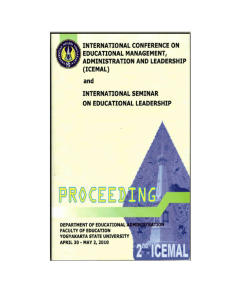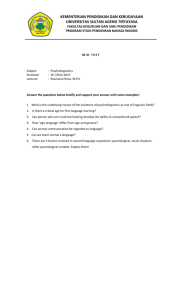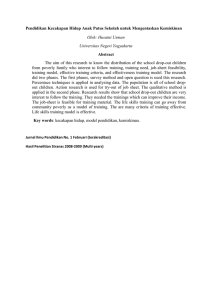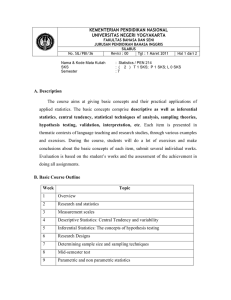1 Faculty of Languages and Arts Sciences Yogyakarta State University Email:
advertisement
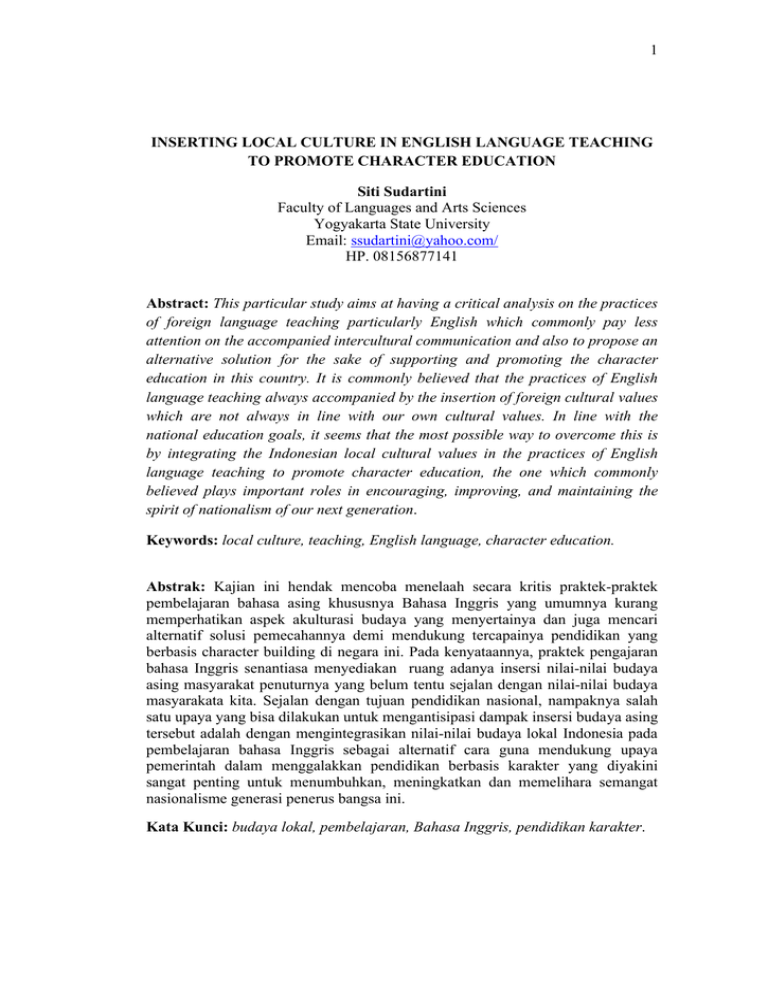
1 INSERTING LOCAL CULTURE IN ENGLISH LANGUAGE TEACHING TO PROMOTE CHARACTER EDUCATION Siti Sudartini Faculty of Languages and Arts Sciences Yogyakarta State University Email: ssudartini@yahoo.com/ HP. 08156877141 Abstract: This particular study aims at having a critical analysis on the practices of foreign language teaching particularly English which commonly pay less attention on the accompanied intercultural communication and also to propose an alternative solution for the sake of supporting and promoting the character education in this country. It is commonly believed that the practices of English language teaching always accompanied by the insertion of foreign cultural values which are not always in line with our own cultural values. In line with the national education goals, it seems that the most possible way to overcome this is by integrating the Indonesian local cultural values in the practices of English language teaching to promote character education, the one which commonly believed plays important roles in encouraging, improving, and maintaining the spirit of nationalism of our next generation. Keywords: local culture, teaching, English language, character education. Abstrak: Kajian ini hendak mencoba menelaah secara kritis praktek-praktek pembelajaran bahasa asing khususnya Bahasa Inggris yang umumnya kurang memperhatikan aspek akulturasi budaya yang menyertainya dan juga mencari alternatif solusi pemecahannya demi mendukung tercapainya pendidikan yang berbasis character building di negara ini. Pada kenyataannya, praktek pengajaran bahasa Inggris senantiasa menyediakan ruang adanya insersi nilai-nilai budaya asing masyarakat penuturnya yang belum tentu sejalan dengan nilai-nilai budaya masyarakata kita. Sejalan dengan tujuan pendidikan nasional, nampaknya salah satu upaya yang bisa dilakukan untuk mengantisipasi dampak insersi budaya asing tersebut adalah dengan mengintegrasikan nilai-nilai budaya lokal Indonesia pada pembelajaran bahasa Inggris sebagai alternatif cara guna mendukung upaya pemerintah dalam menggalakkan pendidikan berbasis karakter yang diyakini sangat penting untuk menumbuhkan, meningkatkan dan memelihara semangat nasionalisme generasi penerus bangsa ini. Kata Kunci: budaya lokal, pembelajaran, Bahasa Inggris, pendidikan karakter. 2 INTRODUCTION It is commonly believed that education plays the most significant role in the development of a nation. Education may be regarded as an investment in human capital formation that lays the foundation for future economic growth and development of a country not to mention our country, Indonesia. Our government even has given explicitly the definition of the term education in the Act of Republic Indonesia on National Educational System that may be considered as, ….conscious and well planned effort in creating a learning environment and learning process so that learners will be able to develop their full potential for acquiring spiritual and religious strengths, develop self-control, personality, intelligence, morals and noble character and skills that one needs for him/herself, for the community, for the nation, and for the State. National education means education based on Pancasila and the 1945 Constitution, and is rooted in the religious values, national cultures of Indonesia, and one that is responsive to the needs of the ever-changing era. (Act Of Republic Indonesia on National Educational System (Chapter 1 Article 1 and 2). In line with this definition, education has also often been defined in terms of practices that schools and teachers use to influence student learning and development (Nucci and Narvaéz, 2008:5). Therefore, it seems very important to pay great attention to the practices of our educational system in our country, considering the fact that it would be impossible to reach the goals of our national educational system without involving all aspects determining the success of educational practices. Those are parents, schools’ elements (not to mention: teachers, students, facilities, etc), and also the government. Hence, it is urgently needed to have a critical study on the practices of education in this country for the sake of providing better generation in the future who can maintain religious, 3 national, and cultural values of this country and at the same time remain actively responsive to the needs of the ever changing era. This particular study, however, tries to have a closer look on the common practices of English language teaching in our country, owing to the fact that education is considered having the greatest chance of providing the learners to have a direct contact with a foreign culture. In line with the national education objectives, this particular study also tends to propose a new perspective in the practice of English language teaching by inserting the local cultures to promote character education in Indonesia. THE COMMON PRACTICE OF ENGLISH LANGUAGE TEACHING IN INDONESIA The need to learn and use English in communication has put English as the most important foreign language in the worldwide and not to mention in this country, Indonesia. Our scholars commonly agree that our young generations need to master English well in order to be able to actively participate in the global world. This has made English becoming one of the most important subjects in schools. Most parents even believe that the earlier children learn English the better. This has been becoming the main reason of introducing English as local content in elementary school or even in some kindergartens. These days, foreign language programmes tend to start at an increasingly early stage not only in Europe but the same trend is observable on other continents as well (Nikolov, 2009:xiii). Following Nikolov, Gonzales (1995:58) 4 states that the domains in which English is used as an international, an auxiliary language for intercultural and intercountry and regional communication, are mostly those of international diplomacy, scientific discourse, and in international trade and business, for it is the language of financial and global financial transactions and the language of trade negotiations and the medium of discourse of international business. This has led English as one of the lingua franca and also encourages the spreads and developments in the English language teaching in the non English speaking countries (Woodford and Jackson, 2003). The current practice of English language teaching has been focused on preparing the students to be able to communicate effectively by using the language. English teachers have done their job very well in motivating their students to learn and use the language. They always try to use various interesting activities to present the context of the given language items being discussed. Some of them even give the explanation on certain language items accompanied by the context of culture in which those items used. This fact is very common in the practice of foreign language classrooms. What may be becoming the main concern is on whether the presentation of this foreign culture is accompanied by the explanation of our own culture. This remains an important question in the current practice of English language teaching in this country. What the teachers commonly do in their teaching is merely attempts to fulfill the objectives of the teaching and learning goals as stated in the current curriculum. Most teachers are busy with finding suitable and relevant materials without having critical analysis on the cultural biases that may be covered within 5 the source materials. What commonly come in their minds is finding the materials which are best fitted the objectives of the teaching and learning activities as mentioned in the curriculum. It is generally agreed so far that the practice of English language teaching will not be effective without discussing its culture. Most educators will agree that teaching the language will be impossible without teaching the culture. Every sentence, expression, word needs to be put in the context of culture of the language. In other words we may say that English teachers could act as a cultural agent as well. Every English teacher needs to realize this, if not they will not only be the cultural agent but also be the agent of the new form of imperialism. The current English language teaching practice may lead the students to have better understanding on foreign culture rather than their own culture or even in the extreme way could lead them to make the foreign culture as their own culture and make them internalize the norms as well as foreign cultural values in their daily lives. Some of our young students may have deep understanding on the foreign culture rather than mastering the language. What may be the most important impact of the current English language teaching practice is the loss of our own culture since our young generations no longer have clear understanding of it. Our own valuable cultural norms and values will be left behind by its descendents as they like to have and behave by using the foreign cultural norms and values. They may even forget their cultural identity. All individuals engage in the foreign language teaching and learning process need 6 to anticipate this by having the cultural awareness of the foreign culture and start having discussion on the national culture while explaining the foreign culture in their classrooms. In doing so, they need to start with understanding the notion of the word ‘culture; itself, for this term has various definitions. One of the definitions is proposed by Mesthrie, Swann, Deumer and Leap (2009:28) who define culture as ‘the way of life of its members; the collection of ideas and habits which they learn, share and transmit from generation to generation’. Culture in this sense is a ‘design for living’, which defines appropriate or acceptable ways and forms of behavior within particular societies. The other definition of culture is the one proposed by Foley (2001:14) that views culture as transgenerational domain of practices through which human organisms in a social system communicate with each other. These definitions particularly see culture as something inherited from generation to generation. On the contrary, Nieto (2010:136) defines culture as “the ever-changing values, traditions, social and political relationships, and worldview created, shared, and transformed by a group of people bound together by a combination of factors that can include a common history, geographic location, language, social class, and religion”. This definition provides a new idea of the term culture. Nieto also makes it clear that everyone has a culture because all people participate in the world through social and political relationships informed by history as well as by race, ethnicity, language, social class, gender, sexual orientation, and other circumstances related to identity and experience. 7 In addition to this definition, Nieto (2010:137-144) also mentions some characteristics of culture. Those characteristics include the followings. First, culture is dynamic, in the sense that it is active, changing, and always on the move, that even in its native contexts, culture is always changing as a result of political, social, and other modifications in the immediate environment. Second, culture is multifaceted. This means, for one thing, that culture cannot be conflated with just ethnicity or race. Third, culture is embedded in context meaning that it is influenced by the environment in which it exists. Fourth, culture is influenced by social, economic, and political factors. It is commonly agreed that culture is bound to a particular context, that it is greatly influenced by the political, historical, and economic conditions in which it is found. Fifth, culture is created and socially constructed. The main underlying reason for this is the fact that human beings as the cultural agents change it. Sixth, culture is learned. It means that culture is not handed down through our genes, nor is it inherited. This is very clear to see, for example, when children from a particular ethnic group are adopted by families from another ethnic group. Nieto (2010:144) adds that culture, especially ethnic and religious culture is learned through interactions with families and communities. It usually is not consciously taught, or consciously learned. That is why it seems so natural and effortless. Lastly, culture is dialectical. Nieto also mentions that a culture is neither “good” nor “bad” in general, but rather embodies values that have grown out of historical and social conditions and necessities. As individuals, we may find elements of our own or others culture uplifting or repugnant. 8 Following Nieto (2010) that culture is not merely seen as something inherited but also it can be something learned, it seems urgently needed to have an innovative way of improving the practice of English language teaching in this country for the sake of maintaining the national identity and achieving the goals of national education stated in the Undang-Undang Republik Indonesia Nomor 20 Tahun 2003 owing to the fact that this particular subject provides students with a direct contact with a foreign culture. THE NOTION OF CHARACTER EDUCATION Following Nucci and Narvaéz (2008:5), education may be defined in terms of practices that schools and teachers use to influence student learning and development although children’s and adolescents’ moral development and character formation, however, are not simply the result of schooling but this is widespread agreement that schools should contribute to students‘ moral development and character formation. Although the term “character education” has not been explicitly mentioned in the Act of Republic Indonesia on National Educational System, but it has beeen becoming the biggest issues in various seminars or any kinds of academic meetings on national education topic. The needs to build the national character have also been becoming one of the central concern of the government. Our government, through the Badan Penelitian dan Pengembangan Kurikulum, Kementrian Pendidikan Nasional even has pulished two books in January 2010 9 concerning the practices of improving the development of culture and character education. The first book is Bahan Pelatihan Penguatan Metodologi Pembelajaran Berdasarkan Nilai-nilai Budaya untuk Meningkatkan Daya Saing dan Karakter Bangsa whereas the second book is Pengembangan Pendidikan Budaya dan Karakter Bangsa. The first book is mainly a kind of teachers’ guideline to conduct the character education in schools while the second is mainly a general supplement for schools to conduct and integrating the character education. Although these two books have merely provided some general overviews of the notion of character education, it shows evidence of the governent’s deep concern on integrating the character education in schools. Therefore, it would be much beneficial if there is an additional discussion on the notion of character education. In addition, Nucci and Narvaes (2008:2) state that in broad terms the debates over moral and character education divide along some dimensions. One broad distinction is between those who view character formation and morality as centered on the cultivation of virtues and those who argue that morality is ultimately a function of judgments made in context. Traditional character educators generally fall within this perspective. On the other hand, those who emphasize the role of reason and judgment draw their philosophical arguments from rationalist ethics with its emphasis on autonomous justification for moral actions based on principles of justice or fairness. This definition provides to terms concerning the notion of character education that can be considered as the moral or the character education. While in 10 the Cambridge Advanced Learners’ Dictionary (2008) the origin and literal meanings of character, however, are the particular combination of qualities in a person or place that makes them different from others. The other definition of the term character coming from the point of view of someone who is moralistic, that is, a person who wishes to treat moral categories as broadly as possible and to give moral terms the most frequent possible use, character will appear to lie entirely within the domain of morality. The education of character, then, will seem coextensive with moral education, and to have a good character equivalent to being morally virtuous to a high degree. Most of us in the latter part of the twentieth century are not moralistic and, thus, will have a less simple and reductive view of what good character is (Kupperman, 1991:9). In line with these definitions, character education also can have some other definitions as mentioned by Berkowitz & Bier (2005:8), namely: 1) Character education is a national movement creating schools that foster ethical, responsible, and caring young people by modeling and teaching good character through emphasis on universal values that we all share. It is the intentional, proactive effort by schools, districts, and states to instill in their students important core, ethical values such as caring, honesty, fairness, responsibility, and respect for self and others. 2) Character education is teaching children about basic human values, including honesty, kindness, generosity, courage, freedom, equality, and respect. The goal is to raise children to become morally responsible, selfdisciplined citizens. 3) Character education is the deliberate effort to develop good character based on core virtues that are good for the individual and good for society. 4) Character education is any deliberate approach by which school personnel, often in conjunction with parents and community members help children and youth become caring, principled, and responsible. 11 Meanwhile, Kementerian Pendidikan Nasional (2010:4) mentions that the term character is closely related to attitudes, behaviours, or personalities of a particular person formed as the result of internalization of believed virtues commonly used as the foundation of his/her views, ways of thinking, attitudes, and behaviours. Therefore, the development of nation character must be done in the form of building individual character. As individuals live in a particular social and cultural environment, the effort of buiding individuals character must be done in his/her own social and cultural environment. In addition, the development of national culture and character must be done in an educational process which consider learners as parts of their social, culture, national cultural settings. THE SIGNIFICANCE OF INSERTING LOCAL CULTURE IN ENGLISH LANGUAGE TEACHING In line with the notion of character education, the practices of foreign language teaching, particularly English language teaching in this country need to have much attention in terms of the internalization of other culture. Brown via Richards and Renandya (2002:12) claims that, “whenever you teach a language, you also teach a complex system of cultural customs, values, and ways of thinking, feeling, and acting”. Therefore, it is considered an important thing that educators and all individuals involving in the practice of a foreign language teaching need to have awareness and sensitivity regarding issues of cultural diversity between English and the local languages as well as the national language, bahasa Indonesia. 12 The government even has done their best to provide chances of developing the practice of educational practices in schools not to mention for the English subject by providing KTSP (Kurikulum Tingkat Satuan Pendidikan). This curriculum supports the idea of integrating the local culture in the school curriculum not to mention the English Language curriculum. The practice of this curriculum gives more opportunities of inserting the local culture in the practice of English language teaching. This insertion of local culture in the practice of English language teaching may be considered essencial due to the fact that this subject is commonly believed to provide the learners having a direct contact to the foreign culture. One thing to be noted is the fact that language can be seen as an unseparable element of culture. Foley (2001:19) mentions that: Language is often treated theoretically as a sub system of culture within cognitive anthropology but in practice and structure of language as revealed by modern linguistics has generally served as the paradigm for analyzing other aspects of culture. Following Foley, Linton (1945 in Mesthrie, et al., 2009:28) defines culture as, “the way of life of its members; the collection of ideas and habits which they learn, share and transmit from generation to generation”. By these definitions, it can be stated that culture can be seen as a‘design for living’, that gives meanings to ways and forms of commonly accepted behaviours of a particular society, while language can be seen as, “a cultural activity and, at the same time, an instrument for organizing other cultural domains” (Sharifian and Palmer, 2007:1). 13 Cultural differences are the main questions of intercultural communications. Grant and Lei (2001:10-11) propose four main problems in the intercultural communication concerning the sociocultural aspects of language, namely: 1) Subjective and objective support of the identity of socio-cultural and linguistic minority students; 2) Constructing curriculum contents implying and reflecting the positive value of the plurality of cultures and languages; 3) Building communicative, action-oriented skills; and 4) Accepting socio-cultural diversity and the plurality of ideas as a challenge for democracy. Hence, it is commonly agreed that the practice of a foreign language teaching, particularly English will not be effectively carried out without giving explanation of its culture. English Language Teaching educators are practically required not only to teach the language but at the same time are required to present the cultural context in which this particular language is used. Meanwhile, the learners are also need to learn not only the language but also learn the culture of the society using it. This phenomenon is particularly common in the practice of a foreign language teaching owing to the fact that to be able to actively communicate using a foreign language, one needs to have not only a good proficiency of the language but also a comprehensive understanding of its culture. This will not be beneficial in terms of maintaining our nation identity. Students or learners may have a new perspective towards their own culture. Some of the learners may consider the ‘new culture’ is better than the ‘previous one’. Teachers need to have a clear explanation on the proposition of ‘Accept the differences’. It must be clearly defined as understanding that there is other culture 14 having different norms and values from one’s own culture. Teachers need to make sure that this lesson will not lead to the belief that the new culture is better than one’s own culture. Teachers need to have an alternative way conducting the process of teaching and learning in their classrooms. Therefore, the need to have a new perspective on the practice of English language teaching by inserting the local culture is unavoidable. The underlying reason of applying this new perspective towards language teaching, is the fact that teachers need to integrate the spirit of character education for the sake of maintaining the nation identity. They must be aware of the internalization of foreign culture in the practice of foreign language teaching. They need to be more careful in explaining materials containing cultural content in order not to make their students having a new semantic frame of their own culture. Teachers also need to wherever possible, promote the local content to the students by inserting the local cultural aspects or local wisdom during their teaching and learning process. This will be important in maintaining the students’ understanding towards their own culture. The term local culture in this sense is closely related to term tradition which can be defined as “inherited behavioural customs remain practiced in the society, coming from the judgements or assumptions that everything formerly exists is the right ones” (Kamus Besar Bahasa Indonesia, 2005:1208). The word tradition leads to the other related term called ‘tradisional’ having a similar meaning, that is a form of attitude or a set of ways of thinking and act that always stick to the inherited norms and customs. 15 Seen from the archeological perspective, the term tradition and local culture refer to the term ‘local genius’ (Koentjaraningrat, 1986:80), that Wales (via Poespowardojo, 1986:30) defines as, “the sum of the cultural characteristic which the vast majority of a people have in common as a result of their experience in early life”. While Anderson (2006:6) uses the term of ‘cultural artefacts of a particular kind’ to refer to the term local genius. By these definitions, the term ‘local genius’ can be seen as the manifestation of society’s personality reflected in the orientation of the society’s ways of life and beliefs that commonly used to see and face the outside world manifested in their daily behaviours. Looking at these definitions of local culture and considering the need to maintain the nation identity, it will be much beneficial to insert the local cultural values and norms in the practice of English language teaching. The insertion of the local cultural values can be an alternative way of preparing the learners’ cultural background and identity that hopefully also improving their nationalism awareness when they contact or learn a foreign culture ideology internalized in the practice of English language teaching. It is widely believed that cultural aculturation through the intercultural communication between Indonesian and a foreign culture particularly Western culture, has commonly inconsciously followed by the internalization of the foreign culture by means of various media, not to mention the English language teaching. This cultural intercultural communication mainly results in the emergence of the construction of domination and hegemony of Western cultural values towards the Indonesian identity and and nationalism. The fact that 16 nationalism is really crucial in the sense of maintaining the nation identity, has been proposed by Anderson (2006:1-15) that views nationalism not only as a imaginary phenomenon (but not imaginative), whose existence always requires to be continually reconstructed and maintained by the whole society. Consequently, the internalization of a foreign culture (Western culture) in the practice of English language teaching needs to be critically concerned as this may make us the victims of a new practice of Western imperialism and colonialism. In relation to the importance of developing, maintaining and preserving the values and the spirits of nationalism for the sake of the naton-state of Indonesia, the whole insertion of local culture in the practice of English language teaching meets its relevance and significance. The insertion of the local culture in the practice of English language teaching can be in the forms of selecting materials containing the local culture norms and values and also giving additional explanation on any foreign cultural norms found in the process of teaching and learning English. This insertion of local culture, however, will not be successfully carried out without the supports of all individuals involved in the practice of English language teaching, such as, the teachers, textbook publishers, parents, as well as the government. CONCLUSION 17 It is widely known that the common practice of English language teaching has been focused on preparing the students to be able to communicate effectively by using the language. Most people agree that the practice of English language teaching of English will not be effective without discussing its culture, therefore teaching a language will be impossible without teaching the culture. This, however, may lead the students to have better understanding on foreign culture rather than their own culture or even in the extreme way could lead them to make the foreign culture as their own culture and make them internalize the norms as well as foreign cultural values in their daily lives. All individuals engage in the foreign language teaching and learning process need to anticipate this by having the cultural awareness of the foreign culture and start having discussion on the national culture while explaining the foreign culture in their classrooms. The fact that the practice of English language teaching cannot be separated from teaching the accompanied culture and by considering the need to maintain the nation identity, it will be much beneficial to insert the local cultural values and norms in the practice of English language teaching. The insertion of the local cultural values can be an alternative way of preparing the learners’ cultural background and identity that hopefully also improve their nationalism awareness when they contact or learn a foreign culture ideology internalized in the practice of English language teaching. This sense of national cultural awareness is actually one of the character education goals (Kementerian Pendidikan Nasional, 2010:7). 18 REFERENCES Anderson, Benedict Richard O'Gorman. 2006. Imagined Communities: Reflections on the Origin and Spread of Nationalism. London, United Kingdom: Verso. Berkowitz, Marvin W. & Melinda C. Bier. 2005. What Works in Character Education: A Research-Driven Guide For Educators. St. Louis: University of Missouri Press. Departemen Pendidikan Nasional. 2005. Kamus Besar Bahasa Indonesia. Cetakan Ketiga, Edisi Ketiga. Jakarta: Balai Pustaka. Foley, William A. 2001. Anthropological Linguistics: An Introduction. Massachusetts: Blackwell Publishers. Gonzales, Andrew. 1995. “The Cultural Content of English as an International Auxiliary Language (EIAL): Problems and Issues”, in Makhan L. Tickoo (ed.), Language and Culture in Multilingual Societies: Viewpoints and Visions. Singapore: SEAMEO Regional Language Centre with Sherson Publishing House, Pte. Ltd. Grant, C. A. and J. L Lei (eds). 2001. Global Constructions Of Multicultural Education: Theories And Realities. New Jersey: Lawrence Erlbaum Associates, Inc. Hornby, A.S. 1987. Oxford Advance Dictionary. Oxford: Press. Oxford University Kementerian Pendidikan Nasional. 2010. Pengembangan Pendidikan Budaya dan Karakter Bangsa: Pedoman Sekolah. Jakarta: Kementerian Pendidikan Nasional, Badan Penelitian dan Pengembangan Pusat Kurikulum. Koentjaraningrat. 1986. “Peranan Local Genius dalam Akulturasi”, dalam Ayatrohaedi, (ed.), Kepribadian Budaya Bangsa (Local Genius). Jakarta: Pustaka Jaya. __________.1990. Pengantar Ilmu Antropologi. Cetakan Kedelapan. Jakarta: Rineka Cipta. 19 Kupperman, Joel J. 1991. Character. Oxford: Oxford University Press. Mesthrie, R., J. Swann, A. Deumer and W. L. Leap. 2009. Introducing Sociolinguistics. Edinburgh: Edinburg University Press. Nikolov, Marianne (ed.). 2009. Early Learning of Modern Foreign Languages: Processes and Outcomes. Second Edition. Bristol: Short Run Press Ltd. Nucci, Larry P. and Darcia Narvaés. 2008. Handbook of Moral and Character Education. New York: Routledge. Poespowardojo, Soerjanto. 1986. “Pengertian Local Genius dan Relevansinya dalam Modernisasi”, dalam Ayatrohaedi (ed.), Kepribadian Budaya Bangsa (Local Genius). Jakarta: Pustaka Jaya. Richards, Jack C and Willy Renandya (eds). 2002. Methodology in Language Teaching: An Anthology of Current Practice. Cambridge: Cambridge University Press. Sharifian, F. and G. B. Palmer. 2007. Applied Cultural Linguistics Implications for Second Language Learning and Intercultural Communication. Amsterdam & Philadelphia: John Benjamins Publishing Company. Walter, Elizabeth (ed). 2008. Cambridge Advanced Learner’s Dictionary 3rd Edition. Cambridge: Cambridge University Press. Woodford, Kate and Guy Jackson (eds.). 2003. Cambridge Advanced Learner’s Dictionary. Cambridge: Cambridge University Press. Artikel ini Dimuat di JURNAL PENDIDIKAN KARAKTER; Diterbitkan oleh Lembaga Pengembangan dan Penjaminan Mutu Pendidikan (LPPMP), Universitas Negeri Yogyakarta; Edisi Tahun II, Nomor 1, Februari 2012. Halaman 45-54. Nomor ISSN: 2089-5003.
